I’ve always had a soft spot for this madcap team of ne’er-do-wells and weirdo villains. There aren’t too many villain teams that get their own comic book, and I love all the arguing, infighting, and rifts that take place in the Society’s pages. Not to mention that Captain Comet, a superhero, actually mistook the costumed criminals for heroes and wanted to join them. But the main reason to use the team? Giant apes. It’s a new rule in Vs. System—all cards with giant apes in the art must be good.
My original ideas for the team’s themes revolved around “pick your poison” and “no deck.” The no deck theme came to me when I watched players at the first PC LA draft Mattie Franklin and run out of cards by replacing every card in their resource rows on turn 6 and then most of their rows again on turn 7. And if Mattie was ever team attacked . . . goodbye deck! I guess I liked watching these games because her power was my idea. I thought it would be cool to have a team that tried to run out of cards so they would gain extra benefits. The pick your poison theme would be nasty effects that gave your opponent built-in ways to stop them. However, the way to stop them was often equally painful. You’ll see.
If you’ve seen the JLA set, you know that there’s a sub-theme of +1 ATK / +1 DEF counter manipulation across both villain teams. It started out as an underwater theme, as The Shark and an early Aquaman also dealt with counters. Just look at Atlantean Trident and check out the artwork on Counterstrike and Counterterrorism. But counters were too perfect for people like Tattooed Man, Living Ink to be limited only to water characters. Plus, everyone knew that water-based characters were supposed to interact with the KO’d pile anyway.
Key
Original: November 2004. By the middle of this month, I had given each character in the set a “first pass” power. These were heavily thematic powers that helped me see where team themes might present themselves.
Turnover: March 8, 2005. This was the day I turned over my design file to the developers.
Development: April 19, 2005—a week after ally became what you see today. Sometimes, the development team made changes. Sometimes, they came to me asking for a rewrite.
Final: This is the text you see on the card today.
Copperhead
Original
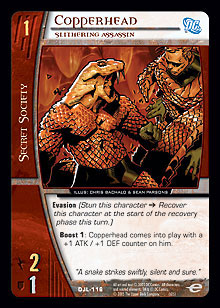 He started out as a 1-cost 2 ATK / 1 DEF.
He started out as a 1-cost 2 ATK / 1 DEF.
“Evasion <p> Whenever Copperhead stuns a character, if there are no cards in your deck, KO that character. <p> Boost 1: When Copperhead comes into play, put a +1 ATK / +1 DEF counter on him.”
He’s a poisonous snake, don’t ya know. This was the earliest of the “no deck” theme cards. It might be tough for a 1-drop to see the day when your deck is gone, but evasion sure helps.
Turnover, Development, and Final
Copperhead, Slithering Assassin
“Evasion <p> Boost 1: Copperhead comes into play with a +1 ATK / +1 DEF counter on him.”
I’ve received a few emails asking if any of my early ideas made it all the way through development completely untouched. That one’s for you guys . . .
Henry King ◊ Brainwave
Original
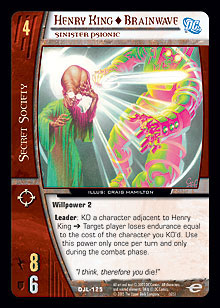 He started out as a 2-cost 2 ATK / 3 DEF.
He started out as a 2-cost 2 ATK / 3 DEF.
“At the start of the combat phase, you may reveal the top card of target player’s deck. Remove that card from the game unless any player pays X endurance, where X is that card’s cost.”
This is an example of a “pick your poison” power. Something bad happens unless you pay. Use it on your opponents to make them pay dearly to keep their 7-cost character. Note that the Society player could choose to use it on either player. You could use it on yourself to improve your draws.
Turnover
“Willpower 1 <p> When Henry King is put into your KO’d pile from play, you may put up to X character cards named Illusionary Warriors from your removed-from-game zone into your front row, where X is Henry King’s willpower.”
I then decided that I wanted him to be a part of the summoners, as he creates psionic warriors. Yes, that’s what’s going on in his picture; this version was what the art description was based on. He references the removed-from-game zone, as that is where a lot of the deck depletion was sending cards. I wanted players to be able to run through their decks very quickly, but not fill the KO’d pile by turn 4.
Development
“Willpower 2 <p> Whenever Henry King becomes stunned, you may KO him. If you do, move target Army character with cost 2 or less to your front row.”
I thought his psionics might make him a good fit in the stealing theme, but this version was too narrow ever to make the cut in a deck.
Final
Henry King ◊ Brainwave
He’s now a 4-cost 8 ATK / 6 DEF.
“Willpower 2 <p> Leader: KO a character adjacent to Henry King >>> Target player loses endurance equal to the cost of the character you KO’d. Use this power only once per turn and only during the combat phase.”
Realizing that the team needed a common leader in the 4-drop slot, Henry got a promotion to a 4-cost character. And now he’s part of the evil leader theme of the set.
James Jesse ◊ Trickster
Original
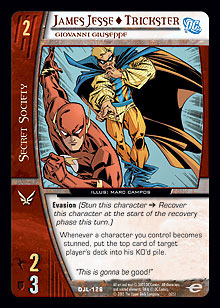 He started out as a 2-cost 3 ATK / 3 DEF.
He started out as a 2-cost 3 ATK / 3 DEF.
“Whenever James Jesse stuns a defender, KO that defender unless any player removes the top two cards of his deck from the game.”
Pick your poison, though it could be used to deplete your own deck. Not likely.
Turnover
“Pay 1 endurance >>> Look at the top card of target player’s deck. You may remove that card from the game or put it on top of that player’s deck. Use this power only once per turn.”
I liked this power, but it was proving a bit too good, as it would really mess with an opponent’s quality of cards drawn.
Development
It’s now a 1-cost 1 ATK / 1 DEF.
“Evasion <p> Ally: Whenever a character you control becomes powered-up, you may look at the top two cards of target player’s deck. If you do, you may put any of those cards into that player’s KO’d pile. Put the remaining cards on top of that player’s deck in any order.”
Now with ally in the picture, I thought the effect might translate well into that theme and happen less often. However, it always delayed the game when it happened.
Final
James Jesse ◊ Trickster
It’s now a 2-cost 2 ATK / 3 DEF.
“Evasion <p> Whenever a character you control becomes stunned, put the top card of target player’s deck into his KO’d pile.”
Now it’s much more streamlined. The effect can still happen a few times each turn, but at least it just takes a second to resolve.
Captain Boomerang, “Digger”
Original
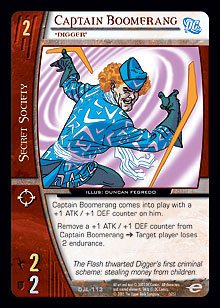 He started out as a 3-cost 3 ATK / 4 DEF.
He started out as a 3-cost 3 ATK / 4 DEF.
“Return Captain Boomerang to owner’s hand >>> Return target character with cost of 3 or less to owner’s hand unless any player discards two cards.”
Pick your poison theme. Or should this be on the Injustice Gang?
Turnover
He’s now a 3-cost 5 ATK / 4 DEF.
“Return Captain Boomerang to his owner’s hand >>> Return target character with cost 3 or less to its owner’s hand unless any player puts two cards from his hand on top of his deck.”
My original didn’t seem good enough, as most of the time the opponent could just discard unwanted characters. Now, putting them on top of the deck made your opponent’s good cards that much farther away.
Development
He’s now a 2-cost 3 ATK / 2 DEF.
“Return Captain Boomerang to his owner’s hand >>> Return target character with cost 2 or less to its owner’s hand unless any player puts two cards from his hand on top of his deck.”
The development team thought the power belonged on a smaller character.
Final
Captain Boomerang, “Digger”
He’s now a 2-cost 2 ATK / 2 DEF.
“Captain Boomerang comes into play with a +1 ATK / +1 DEF counter on him. <p> Remove a +1 ATK / +1 DEF counter from Captain Boomerang >>> Target player loses 2 endurance.”
We finally realized that the pick your poison theme wasn’t working as well as we had wanted it to, but the Boomerang “return to hand” power was perfect for the Injustice Gang version of the character. Digger now comes into play with a boomerang that he can toss at someone, which plays very well with the +1 ATK / +1 DEF counters the Society has access to.
Crystal Frost ◊ Killer Frost
Original
 She started out as a 3-cost 4 ATK / 4 DEF.
She started out as a 3-cost 4 ATK / 4 DEF.
“When Crystal Frost comes into play, exhaust target character with cost 3 or less. <p> While there are no cards in your deck, characters opponents control with a cost of 2 or less can’t ready.”
The first power seemed a bit too good, while the no deck power would require her to be around in the late game, when the power wouldn’t usually mean much.
Turnover
She’s now a 3-cost 3 ATK / 6 DEF.
“Remove the top three cards of your deck from the game >>> Target character with cost 3 or less can’t ready this turn. Use this power only during the recovery phase. <p> Boost 1: When Crystal Frost comes into play, exhaust target character with cost 3 or less.”
Now the exhaust is a boost power, and the character is trying to do too much.
Development
She’s now a 5-cost 10 ATK / 8 DEF.
“Ally: Whenever a character you control becomes powered-up, you may remove two cards in your KO’d pile from the game. If you do, target character cannot ready this turn. <p> Boost 1: When Crystal Frost comes into play, if you control another Secret Society character, exhaust target character with cost 5 or less.”
Her power fit well into the ally mold, but her boost power was now rather unnecessary.
Final
Crystal Frost ◊ Killer Frost
“Ally: Whenever a character you control becomes powered-up, you may remove three cards in your KO’d pile from the game. If you do, target character cannot ready this turn.”
In testing, two cards were too little, so three (the magic number of Vs. System) was naturally the answer.
Poison Ivy, Kiss of Death
Original
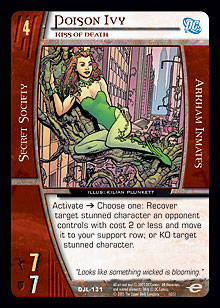 She started out as a 6-cost 12 ATK / 12 DEF.
She started out as a 6-cost 12 ATK / 12 DEF.
“At the start of the combat phase, target opponent loses 1 endurance for each location you control. <p> Discard a location card >>> Target opponent loses 2 endurance. Use this power only if there are no cards in your deck.”
I wanted locations to play a big part in the Society theme, and this would have been a burn finisher for them.
Turnover
She’s now a 4-cost 6 ATK / 8 DEF.
“When Poison Ivy is put into your KO’d pile during the build or combat phase, locations you control are not unique this turn. <p> Boost 1: Poison Ivy gets +1 ATK this turn for each location you control.”
The janky wording is supposed to make you want to KO her to an evil leader or the Sinister Citadel. But triggers that happen during recovery are a pain.
Development
“Pay 1 endurance >>> Locations your opponents control cannot ready this phase. <p> Ally: Whenever a character you control becomes powered-up, you may negate target location effect.”
This was a bit too narrow, and we wanted a well-known character like her to see lots of play.
Final
Poison Ivy, Kiss of Death
She’s now a 4-cost 7 ATK / 7 DEF.
“Activate >>> Choose one: Recover target stunned character an opponent controls with cost 2 or less and move it to your support row; or KO target stunned character.”
Now it’s like a pick your poison card, but you get to do the picking.
Scarecrow, Fearmonger
Original
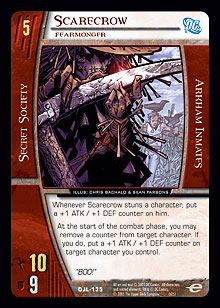 He started out as a 4-cost 7 ATK / 7 DEF.
He started out as a 4-cost 7 ATK / 7 DEF.
“Whenever a character an opponent controls attacks a character with a lower cost, that character’s controller loses 3 endurance.”
The problem with this kind of effect is that once you take down Scarecrow, the power shuts off.
Turnover
He’s now a 6-cost 12 ATK / 10 DEF.
“Whenever Scarecrow attacks a character with a lower cost, that defender loses reinforcement and can’t gain reinforcement this turn.”
I decided to turn the fear effect to the offense. However, I knew this would be too weak.
Development
He’s now a 6-cost 12 ATK / 11 DEF.
“Whenever Scarecrow becomes stunned, characters your opponents control get -2 DEF this turn.”
Now he works well as a first attacker for the turn, but we decided we wanted to make him a bit more relevant to the metagame.
Final
Scarecrow, Fearmonger
He’s now a 5-cost 10 ATK / 9 DEF.
“Whenever Scarecrow stuns a character, put a +1 ATK / +1 DEF counter on Scarecrow. <p> At the start of the combat phase, you may remove a counter from target character. If you do, put a +1 ATK / +1 DEF counter on target character you control.”
Now he makes Nimrod cry. He also fits in quite well with the Society’s counter creation and manipulation theme.
Gorilla Grodd
Original
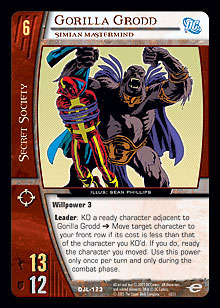 He started out as a 4-cost 7 ATK / 6 DEF.
He started out as a 4-cost 7 ATK / 6 DEF.
“Pay 3 endurance >>> Gorilla Grodd gets +1 ATK this attack. <p> Boost 1: When Gorilla Grodd comes into play, move target character with cost 2 or less to your support row. (You gain control of it.)”
I wanted to represent his mind control powers from the start. His ATK pump eventually found its way to Gorilla City.
Turnover
He’s now a 5-cost 10 ATK / 8 DEF.
“Leader: Adjacent characters gain the Secret Society affiliation. (This is in addition to any other affiliations.) <p> Boost 1: When Gorilla Grodd comes into play, move target character with cost 2 or less to your support row. (You gain control of it.)”
Since he was one of many who claimed leadership of the team, he should be a part of that theme. However, now that he’s a 5-drop, the boost power is pretty weak.
Development
He’s now a 6-cost 13 ATK / 12 DEF.
“Willpower 3 <p> Leader: Whenever an adjacent attacker stuns a defender with cost less than or equal to Gorilla Grodd’s willpower, you may move that stunned character to your front row.”
Since he’s a giant ape with mind powers, he deserved some willpower. This proved a bit too scary if he ever had a willpower-increasing ring on, especially when it could happen multiple times in a turn.
Final
“Willpower 3 <p> Leader: KO a ready character adjacent to Gorilla Grodd >>> Move target character to your front row if its cost is less than that of the character you KO’d. If you do, ready the character you moved. Use this power only once per turn and only during the combat phase.”
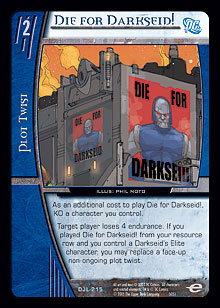 Now his power works just once per turn, which is certainly fair, huh? As the literal and figurative “800-pound Gorilla” of Sealed Pack play, you just need to be ready for him. There are risks to using his power. Should his power be negated, the Grodd player is in dire straights. Die for Darkseid! is the number one best way to hose the Grodd player completely. When your opponent KO’s his or her 7-drop to steal your 6-drop, play Die for Darkseid! in response, targeting your 6-drop. Give your opponent a quick 4 endurance loss and a “thanks for playing.” Anything that can remove Grodd’s target from the board works just fine. Funeral for a Friend and Sinister Citadel are two of the other surprise negations available to you. There are a half dozen other cards that will stop Grodd or at least deter him from using his mind control powers.
Now his power works just once per turn, which is certainly fair, huh? As the literal and figurative “800-pound Gorilla” of Sealed Pack play, you just need to be ready for him. There are risks to using his power. Should his power be negated, the Grodd player is in dire straights. Die for Darkseid! is the number one best way to hose the Grodd player completely. When your opponent KO’s his or her 7-drop to steal your 6-drop, play Die for Darkseid! in response, targeting your 6-drop. Give your opponent a quick 4 endurance loss and a “thanks for playing.” Anything that can remove Grodd’s target from the board works just fine. Funeral for a Friend and Sinister Citadel are two of the other surprise negations available to you. There are a half dozen other cards that will stop Grodd or at least deter him from using his mind control powers.
Grodd is a common, as we wanted to have a common leader at each drop to play up the “dueling leaders” aspect of the team. We also wanted to make sure the Secret Society stealing theme was available for Sealed play. Remoni Notra ◊ Star Sapphire, Zamoran Champion’s ability is not the sort of power that would be as universally useful on a common. Commons are supposed to be the cards that almost every Sealed Pack deck can use.
Okay, due to popular demand, I will write a fifth article on the evolution of some of the more popular non-character cards in the set. Thanks for your emails and for the card evolution requests. I should be able to include all of the requests I’ve received over the past three weeks, but it’s too late for any more new requests.
Send questions and comments to mhyra@metagame.com.